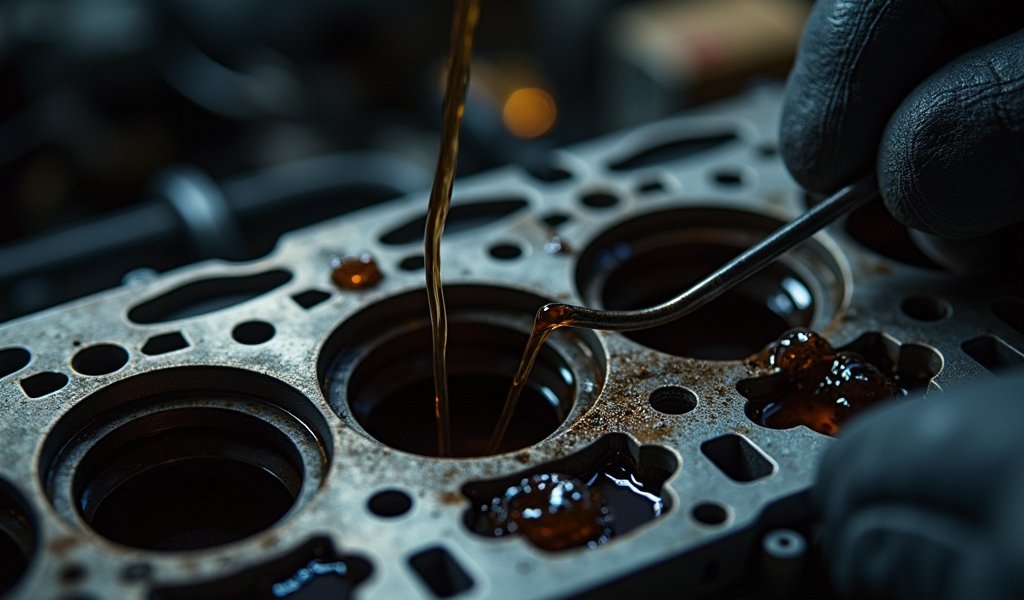Overview
This article provides a detailed guide to valve stem seal replacement, explaining their function, signs of failure, and step-by-step replacement instructions for DIY enthusiasts. It compares DIY vs professional costs ($130-350 vs $500-2500) while sharing personal experiences and common mistakes to avoid when performing this intermediate-to-advanced engine repair that helps prevent oil consumption and blue exhaust smoke.
Table of Contents
- Understanding Valve Stem Seals: What They Do and Why They Fail
- 5 Signs Your Valve Stem Seals Are Failing
- Tools and Materials You’ll Need for Replacement
- Step-by-Step Valve Stem Seal Replacement Procedure
- My First Valve Stem Seal Replacement: Lessons From the Trenches
- 6 Common Mistakes to Avoid During Valve Stem Seal Replacement
- Cost Comparison: DIY vs. Professional Replacement
- Conclusion: Is Replacing Valve Stem Seals Worth It?
- Frequently Asked Questions
Understanding Valve Stem Seals: What They Do and Why They Fail
Let me introduce you to one of the unsung heroes of your engine’s valve train: the humble valve stem seal. These tiny rubber components might look insignificant, but they’re crucial to your engine’s performance and longevity. The valve stem seal replacement procedure is something every serious DIYer should understand, even if you eventually decide to leave it to the professionals.
Think of valve stem seals as the doormen of your engine’s combustion chamber. Their job? To control oil flow, allowing just enough lubrication for the valve stems while preventing excess oil from sneaking into the combustion chamber. Like bouncers at an exclusive club, they’re strict about what gets in and what stays out.
These seals typically last 80,000 to 100,000 miles, but like any rubber component living in the sauna-like conditions of your engine, they eventually deteriorate. Heat is their primary enemy, slowly cooking these rubber components until they harden, crack, and lose their ability to seal properly. Modern synthetic rubber compounds have improved durability significantly, but nothing lasts forever under your hood.
When these seals fail, it’s like leaving the door to the oil storage room wide open. Engine oil that should stay in the valve cover area sneaks past the worn seals and works its way into places it shouldn’t be – namely, your combustion chambers. The result? A cascade of performance issues that we’ll explore next.
5 Signs Your Valve Stem Seals Are Failing
Before we dive into wrenches and sockets, let’s make sure we’re diagnosing the right issue. Valve stem seal failure has some distinctive calling cards that separate it from other engine troubles:
- Blue-gray exhaust smoke – Especially noticeable after the engine has been idling or when you accelerate after coasting
- Increased oil consumption – You’re adding oil between changes, but there’s no visible external leak
- “Cold start puff” – A distinctive plume of bluish smoke after starting the car when it’s been sitting overnight
- Spark plug fouling – Oil-fouled spark plugs can cause misfires and rough running
- Declining acceleration – Gradual loss of engine power and responsiveness
The “cold start puff” is particularly telling. Here’s what happens: when your engine sits overnight, oil seeps past the worn seals and pools in the combustion chambers. When you fire up the engine in the morning, that oil burns off in one dramatic blue cloud. If your neighbors are complaining about your car’s morning breath, failing valve stem seals might be the culprit.
These symptoms can sometimes be confused with piston ring issues, but there’s a key difference. With valve stem seals, the oil consumption and smoke typically worsen during idle and deceleration, while piston ring problems usually show up more during acceleration and under load. If your camshaft timing chain is also showing signs of wear, you might want to address both issues simultaneously.

Tools and Materials You’ll Need for Replacement
Ready to tackle this job? Think of yourself as a surgeon preparing for an operation. You need the right tools, the right parts, and a clean environment. Here’s your shopping list:
- Essential Tools:
- Valve spring compressor (specific to your engine type)
- Compressed air tool (to prevent valves from dropping into cylinders)
- Socket set and extensions
- Torque wrench
- Valve seal installation tool
- Pliers for removing valve keepers
- Clean rags and brake cleaner
- Required Materials:
- New valve stem seals (matched precisely to your engine)
- Head gasket set (if removing the cylinder head)
- Engine oil and filter (for post-repair change)
- Assembly lube
- Thread sealant (if applicable)
Don’t cut corners on the quality of your replacement valve stem seals. This is a classic “buy once, cry once” scenario. Premium seals from reputable manufacturers will cost a bit more, but they’re engineered to withstand the heat and chemical assault of modern engines. As engine building experts emphasize, using OEM-quality seals can prevent premature failure and the need to repeat this labor-intensive job.
One tool deserves special mention: the valve spring compressor. This isn’t a one-size-fits-all tool, and using the wrong type can turn a challenging job into an impossible one. Research the specific compressor style that works for your engine layout, whether it’s overhead cam, pushrod, or something more exotic.
Step-by-Step Valve Stem Seal Replacement Procedure
Alright, let’s roll up our sleeves and dive into the procedure. I’ve broken this down into manageable chunks, but remember: this is an intermediate to advanced-level job. Take your time, and don’t rush.
Preparation Phase
1. Disconnect the battery and relieve fuel system pressure according to your vehicle’s service manual.
2. Remove components blocking access to the cylinder head, which typically include:
- Air intake assembly
- Valve/rocker cover
- Ignition coils and spark plugs
- Any accessory brackets in the way
3. Rotate the engine to TDC (Top Dead Center) for cylinder #1. This position helps prevent valves from dropping when working on the head.
4. If you’re not removing the cylinder head, you’ll need to prevent the valves from falling into the cylinders. You have two options:
- Use compressed air through the spark plug holes (6-8 bar pressure)
- Rotate to close the valves on the cylinder you’re working on
Removing Old Valve Stem Seals
5. If working with the head in place, remove the rocker arms, cam followers, or whatever components sit atop your valve springs.
6. Position your valve spring compressor and carefully compress the spring.
7. Once compressed, remove the valve keepers (those tiny, easily lost split collets) using a magnetic tool or needle-nose pliers.
8. Release the spring compressor slowly and remove the retainer, spring, and any shims.
9. Now you can see the old valve stem seal. Use needle-nose pliers to carefully pull it straight up and off the valve stem.
10. Inspect the valve stem for scoring or damage. If you see significant wear, you might need to reconsider a valve job instead of just seal replacement.
Installing New Valve Stem Seals
11. Clean the valve stem thoroughly with brake cleaner and a lint-free cloth.
12. Apply a tiny amount of clean engine oil to the valve stem.
13. Place the new seal on your installation tool, which typically has a centering pin.
14. Carefully slide the tool over the valve stem and push down with steady pressure until the seal seats completely.
15. Reinstall the spring, retainer, and compress the assembly to replace the valve keepers.
16. Repeat this process for each valve, working methodically to avoid confusion.
Reassembly
17. Once all seals are replaced, reinstall the valve train components in reverse order of removal.
18. Carefully adjust valve lash if your engine requires it.
19. Reinstall the variable valve timing solenoid and any related components.
20. Torque all fasteners to factory specifications – this is where your service manual is worth its weight in gold.
21. Reinstall peripheral components like the valve cover (with a new gasket), intake manifold, etc.
22. Change the oil and filter before starting the engine.
My First Valve Stem Seal Replacement: Lessons From the Trenches
I’ll never forget my first valve stem seal job on my trusty old Toyota 22R engine. It was a Sunday afternoon, and I was feeling ambitious after watching a couple of YouTube videos. “How hard could it be?” I thought. Famous last words.
The disassembly went smoothly enough. I had the valve cover off, the rocker arms removed, and was feeling pretty confident. Then came the valve spring compression. The cheap universal compressor I bought online was about as useful as a chocolate teapot. It kept slipping off, and I couldn’t get enough leverage in the tight engine bay.
After a frustrating hour, I called my mechanic friend Mike who brought over a proper tool designed specifically for overhead cam engines. The difference was night and day. What had been impossible suddenly became manageable.
But my learning curve wasn’t over. On valve number three, I wasn’t paying attention and lost one of the valve keepers. It disappeared into the dark recesses of the engine bay, never to be seen again. A two-hour trip to the parts store later (the only place open on Sunday), and I was back in business.
By the time I finished the job, my three-hour project had turned into a two-day marathon. But when I fired up that engine and saw no blue smoke for the first time in months, the feeling of accomplishment was worth every skinned knuckle and colorful word uttered.
The lesson? Respect the job, get the right tools, and prepare for the unexpected. Oh, and maybe set aside twice as much time as you think you’ll need.

6 Common Mistakes to Avoid During Valve Stem Seal Replacement
Even seasoned mechanics can fall prey to these common pitfalls. Let’s make sure you don’t join their ranks:
- Using the wrong tools – That universal valve spring compressor might work on some engines, but many require specialized tools. Do your research before starting.
- Dropping valves into cylinders – Failing to keep the valves from falling can turn a repair into a disaster. Always use compressed air or ensure the valves are closed on the cylinder you’re working on.
- Mixing up valve components – Those tiny keepers, springs, and retainers aren’t necessarily identical across all valves. Keep them organized by cylinder and valve position.
- Installing seals without lubrication – Dry installation can damage both the seal and valve stem. A light coat of clean engine oil is essential.
- Using excessive force – The delicate valve stems can be bent if you get too aggressive with the spring compressor. Patience is your friend here.
- Skipping inspection steps – While you have things apart, check valve guides for wear and carbon buildup on valve stems. These issues can compromise your new seals’ effectiveness.
Perhaps the most insidious mistake is what I call “while-you’re-in-there syndrome.” Yes, access to these components is rare, making it tempting to replace everything you can reach. But scope creep can turn a weekend project into a month-long ordeal. Unless you’ve budgeted the time and money for a complete valve job or head rebuild, stick to the task at hand.
According to Motor Magazine’s technical experts, improper seal installation accounts for nearly 65% of premature seal failures. Taking your time and following proper procedures pays dividends in longevity.
Cost Comparison: DIY vs. Professional Replacement
Let’s talk dollars and cents. This repair can vary dramatically in cost depending on whether you do it yourself or hire a pro, and on what type of engine you’re working with.
For a DIY job, your costs will include:
- Valve stem seals kit: $20-$50
- Specialized tools (if you don’t already have them): $50-$150
- Gaskets and seals for reassembly: $30-$100
- Oil and filter change: $30-$50
- Total DIY cost: $130-$350
Professional replacement costs vary widely:
- Independent garage: $500-$1,000 (cylinder head in place)
- Dealership: $700-$1,500 (cylinder head in place)
- With cylinder head removal: Add $500-$1,000
- Total professional cost: $500-$2,500
The eye-popping difference comes down to labor. This job typically takes 4-8 hours for an experienced mechanic, and shop rates range from $90-$150 per hour. The complexity increases exponentially on engines with multiple camshafts or difficult access.
Consider this, though: if you’re attempting this for the first time, you might spend 10-16 hours on the job. Valuing your time at even $25 per hour, that’s an additional $250-$400 in “sweat equity.” Sometimes, especially for complex engines or when special tools would be a one-time use, the professional route makes economic sense.
Conclusion: Is Replacing Valve Stem Seals Worth It?
After walking through this valve stem seal replacement procedure, you might be wondering if it’s worth the effort. The answer, like many things in the automotive world, is: it depends.
For a well-maintained engine with plenty of life left, addressing failing valve stem seals is absolutely worthwhile. The improved oil consumption, reduced emissions, and restored performance make a compelling case for either DIY repair or professional service.
However, if your engine has high mileage and multiple issues, replacing just the valve stem seals might be putting a Band-Aid on a bigger problem. In these cases, a more comprehensive rebuild might be the wiser long-term investment.
What I can tell you with certainty is this: few repairs give you the same satisfaction as eliminating that telltale blue smoke. There’s something deeply rewarding about addressing a specific engine issue and seeing immediate, visible results.
Whether you decide to tackle this job yourself or leave it to the professionals, understanding the procedure helps you make informed decisions about your vehicle’s maintenance. And in the world of car ownership, knowledge truly is power – or in this case, restored horsepower!
Frequently Asked Questions
How long do valve stem seals typically last?
Valve stem seals typically last 80,000-100,000 miles under normal driving conditions. Heat, oil quality, and driving habits can significantly impact their lifespan.
Can I drive with bad valve stem seals?
Yes, but expect increased oil consumption, potential spark plug fouling, and reduced performance. The blue smoke emissions might also fail environmental tests in some regions.
Do I need to remove the cylinder head to replace valve stem seals?
Not necessarily, though it makes the job easier. Special tools allow for in-vehicle replacement by holding the valves in place with compressed air.
How long does a valve stem seal replacement take?
A professional mechanic typically needs 4-8 hours depending on engine design. A DIY enthusiast should plan for 8-16 hours for their first attempt.
Will new valve stem seals improve fuel economy?
They can modestly improve fuel economy by restoring proper combustion conditions. Expect a 3-5% improvement if oil consumption was previously significant.

